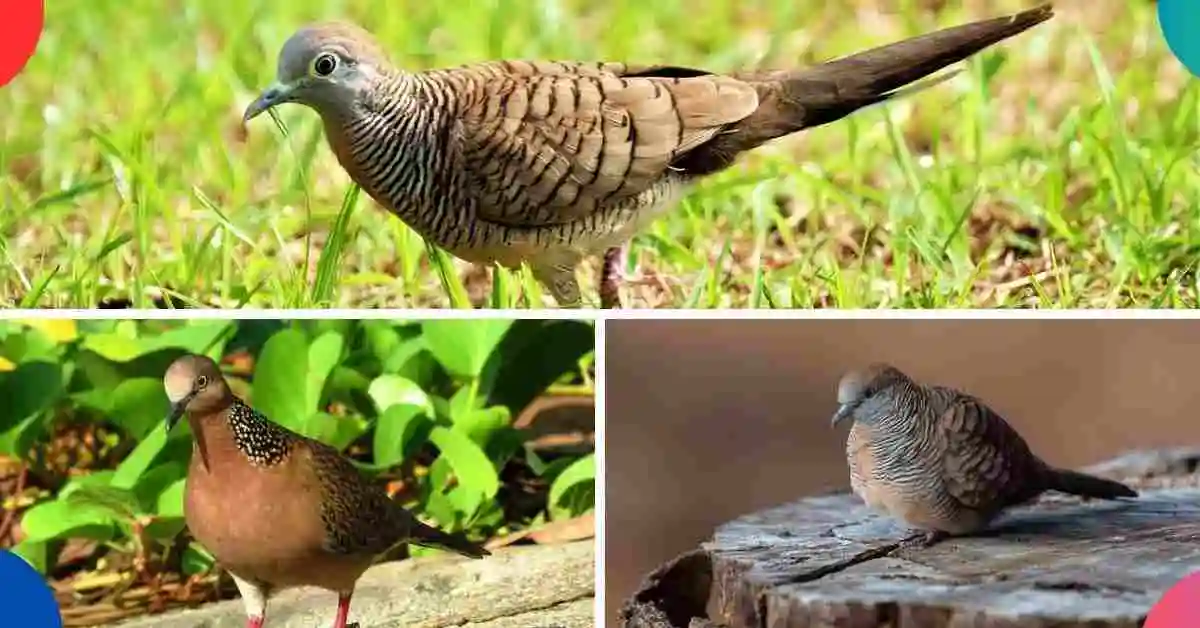
Hawaii has its own natural beauty and unique wildlife. The islands are home to an incredibly diverse of birds such as doves and other species.
Hawaii Doves play an important role in the state’s ecology and cultural heritage.
In this blog post, we will explore the 5 types of doves in Hawaii, their characteristics, habitat, diet, and also location.
What kind of doves are in Hawaii?
There are 5 types of doves commonly found in Hawaii. Here are the bird’s name, habitat, description, diet, fun facts, etc.
- Spotted Dove
- Barred Dove
- Zebra Dove
- Mourning Dove
- Eurasian Collared Dove
Whether you are a bird lover or photographer or just curious to know about Hawaii’s beautiful species of doves join us. We will discover the fascinating world of doves in Hawaii.
Related: Are There Doves in Hawaii?
1. Spotted Dove in Hawaii
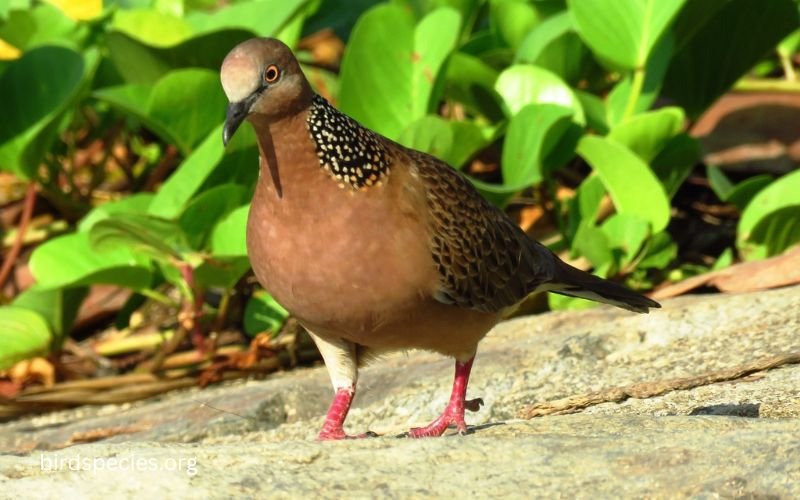
The Spotted Dove is a medium-sized bird with a long tail. This is the most common dove species in Hawaii with spotted plumage.
Spotted Doves are native to Asia but were introduced to Hawaii in the late 1800s as game birds. This species of dove is like Hawaii’s warm and dry climate.
| Aspect | Information |
|---|---|
| Scientific Name | Spilopelia chinensis |
| Common Name | Spotted Dove |
| Status | Least Concern (IUCN) |
| Appearance | Medium-sized dove with a greyish body, white spots on the neck, and a distinctive black half-collar |
| Size | Length: 25-30 cm (9.8-11.8 in); Weight: 90-150 g (3.2-5.3 oz) |
| Habitat | Urban areas, gardens, open woodlands, and agricultural lands |
| Range | Native to Southeast Asia; introduced to parts of Australia and several Pacific islands |
| Diet | Seeds, fruits, and grains |
| Behavior | Forages on the ground, often seen in pairs or small groups |
| Nesting | Nests in trees, shrubs, or on buildings; simple platform nest |
| Reproduction | Lays 2 white eggs; 14-day incubation |
| Lifespan | Typically 3-5 years in the wild |
| Threats | Predation and habitat loss |
| Conservation | Stable population, adaptable to urban and rural environments |
They always prefer a variety of habitats like urban areas, agricultural fields, woodland, scrub, farmland, habitation, and gardens.
Spotted Doves are known for their distinctive cooing call. They are generally considered to be non-migratory in Hawaii. Spotted Doves feed on grass seeds, grains, fallen fruits, and seeds of other plants.
Spotted Doves are important seed dispersers in Hawaii’s ecosystem, helping to spread plant species throughout the islands.
The Spotted Dove is vulnerable in the IUCN list due to habitat loss and is hunted by cats and rats.
Conservation efforts for Spotted Doves in Hawaii include monitoring their population trends and habitat use and studying their behavior and ecology.
Related: Green Birds in Florida
2. Zebra Dove in Hawaii
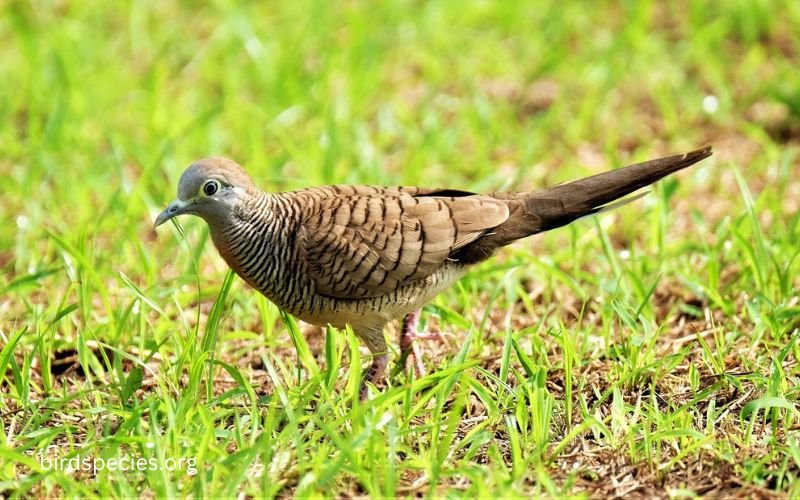
The Zebra Dove is also known as the ground dove. They are native to Southeast Asia. They have long tails with small bodies.
| Aspect | Information |
|---|---|
| Scientific Name | Geopelia striata |
| Common Name | Zebra Dove |
| Status | Least Concern (IUCN) |
| Appearance | Small dove with a distinctive striped (zebra-like) pattern on the chest, grey body, and a black eye ring |
| Size | Length: 22-25 cm (8.7-9.8 in); Weight: 60-90 g (2.1-3.2 oz) |
| Habitat | Open woodlands, gardens, urban areas, and agricultural lands |
| Range | Native to Southeast Asia; introduced to parts of Australia and several Pacific islands |
| Diet | Seeds, fruits, and grains |
| Behavior | Forages on the ground, often seen in small groups or pairs |
| Nesting | Nests in trees, shrubs, or on buildings; simple platform nest |
| Reproduction | Lays 2 white eggs; 12-14 day incubation |
| Lifespan | Typically 4-5 years in the wild |
| Threats | Predation and habitat loss |
| Conservation | Stable population, adaptable to various environments |
Zebra Dove’s upper parts are a brown and gray color and the underparts are pinkish with black colours. You can also see their eyes are blue and their face is blue-grey.
They have also brown feathers. They can grow up to 23 centimeters in length with a wingspan of 24-26 cm. They are known for their “cooing” call.
If you ever go to Hawaii you can see these dove species in grassy areas and open woodlands, but can also be found in urban environments like parks and gardens.
Zebra Doves eat seeds and insects, but they will also eat small fruits and other vegetation. Zebra Doves have a black and white striped pattern on their necks, hence the name “Zebra“. They also have short thin beaks and reddish-brown eyes.
Related: Discover 3 Types of Doves in Massachusetts
3. Mourning Dove in Hawaii
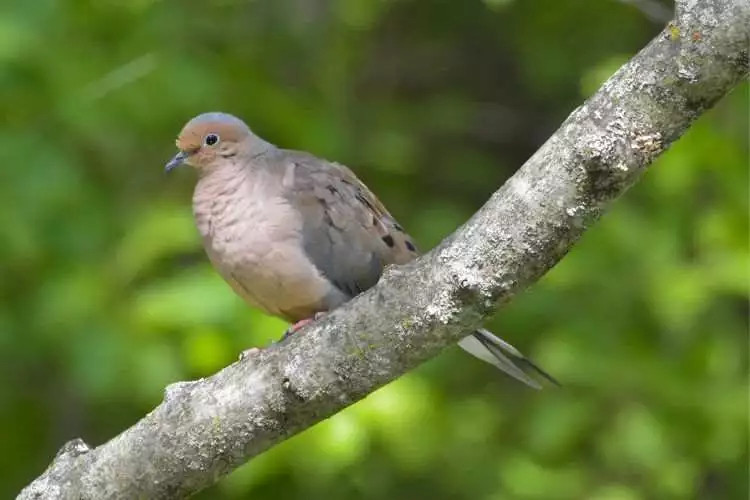
Mourning Doves are another type of Doves in Hawaii. They are also non-native species in this state.
| Aspect | Information |
|---|---|
| Scientific Name | Zenaida macroura |
| Common Name | Mourning Dove |
| Status | Least Concern (IUCN) |
| Appearance | Slender, greyish-brown body, long pointed tail, black spots on wings |
| Size | Length: 23-34 cm (9.1-13.4 in); Weight: 112-170 g (4.0-6.0 oz) |
| Habitat | Open and semi-open areas, including urban areas, farms, and grasslands |
| Range | Throughout North America, parts of Central America and the Caribbean |
| Diet | Seeds, grains, occasionally insects |
| Behavior | Ground forager, often seen in flocks |
| Nesting | Nests in trees, shrubs, or on buildings; flimsy platform nest |
| Reproduction | Lays 2 white eggs; 14-day incubation |
| Lifespan | Typically 1.5 years in the wild, but can live up to 5-7 years |
| Threats | Predation, habitat loss, hunting |
| Conservation | Stable population, benefits from habitat conservation efforts |
Mourning Dove is commonly seen in telephone wires in some places, and it forages seeds on the ground.
This dove has a slender tail, a small head, black eyes, and a small black beak.
Mourning Dove can grow up to 9-13 inches long with a wingspan of 15-18 inches.
Mourning Doves eat corn, millet, buckwheat, Rye, pine nuts, foxtail, peanuts, canary grass, wheat, sunflower seeds, rapeseed, etc. In winter, they mostly eat foxtail millet and corn.
This dove has a long tail, short legs, overall greyish-brown color body, with black spots on the wings. They are looking very beautiful when they are in a grooming position.
4. Barred Dove in Hawaii
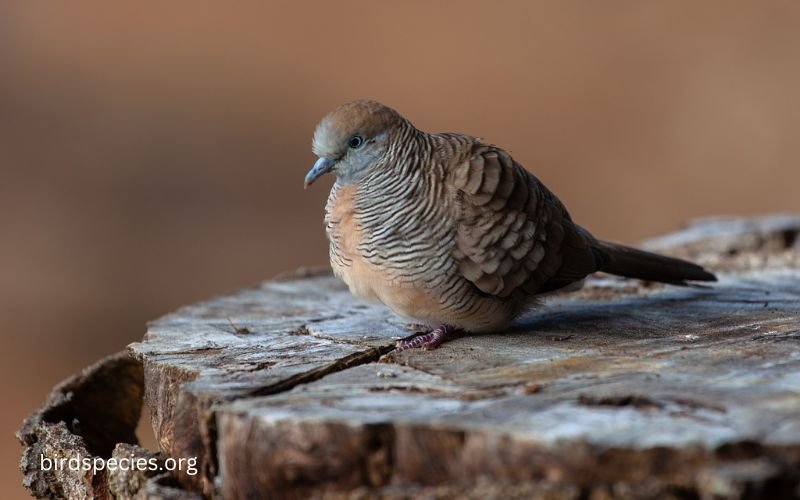
The Barred Dove, also known as the Zebra Dove, is a bird species found in Southeast Asia and nearby Pacific islands, also sometimes seen in Hawaii.
| Aspect | Information |
|---|---|
| Scientific Name | Geopelia striata |
| Common Name | Barred Dove |
| Status | Least Concern (IUCN) |
| Appearance | Small dove with barred chest, grey body, and black eye ring |
| Size | Length: 22-25 cm (8.7-9.8 in); Weight: 60-90 g (2.1-3.2 oz) |
| Habitat | Open areas, gardens, and urban places |
| Range | Australia, parts of Southeast Asia; introduced to some Pacific islands |
| Diet | Seeds, fruits, and grains |
| Behavior | Forages on the ground, often in small groups |
| Nesting | Nests in trees, shrubs, or buildings; simple platform nest |
| Reproduction | Lays 2 white eggs; 12-14 day incubation |
| Lifespan | Usually 4-5 years in the wild |
| Threats | Predation and habitat loss |
| Conservation | Stable population, adaptable to various environments |
Barred Doves are small birds. They can grow up to 20 cm in length. They have light brown bodies with black and white stripes on their necks, giving them a “barred” appearance.
Their wings and back are black and white markings. They have short, thin beaks and reddish-brown eyes.
Barred Doves feed on seeds, fruits, and insects. They are commonly found in grasslands, open woodlands, and urban areas like gardens and parks.
Barred Doves are also known for their soft, melodic cooing calls, which can often be heard in the early morning and late afternoon.
5. Eurasian Collared Dove in Hawaii
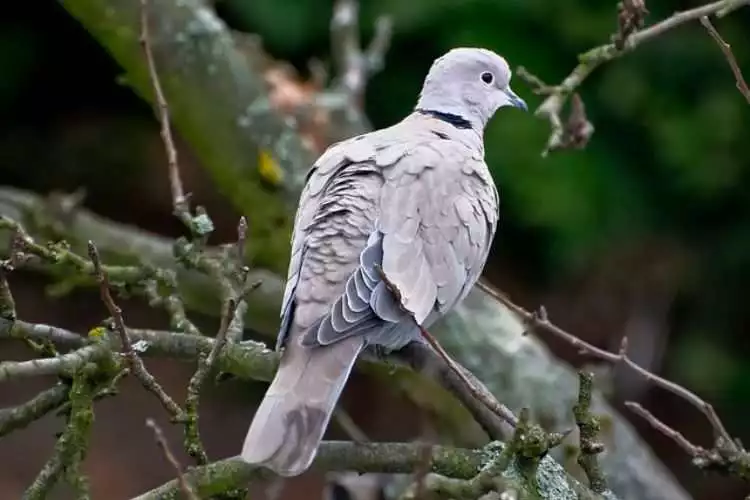
The Eurasian Collared Doves are another type of dove species in Florida and Hawaii. This species of dove is also a non-native species in this state.
| Aspect | Information |
|---|---|
| Scientific Name | Streptopelia decaocto |
| Common Name | Eurasian Collared-Dove |
| Status | Least Concern (IUCN) |
| Appearance | Pale grey body, black crescent-shaped collar on the neck, white-tipped tail |
| Size | Length: 32-34 cm (12.6-13.4 in); Weight: 150-260 g (5.3-9.2 oz) |
| Habitat | Urban areas, farmlands, woodlands |
| Range | Native to Europe and Asia; introduced to North America and other regions |
| Diet | Seeds, grains, some fruits |
| Behavior | Often seen in pairs or small flocks, ground forager |
| Nesting | Nests in trees, buildings, or other structures; simple platform nest |
| Reproduction | Lays 2 white eggs; 14-18 day incubation |
| Lifespan | Typically 3-5 years in the wild, up to 13 years in captivity |
| Threats | Predation, competition with native species |
| Conservation | Stable population, widespread and adaptable |
If we talk about the most common dove species in America, then this species is on the top for sure.
They are medium-sized doves with greyish feathers all over their body.
Eurasian Collared-Dove’s main habitats include bare ground, telephone wires, and trees like the Mourning Dove.
The main food of this species is corn, millet, buckwheat, Rye, pine nuts, canary grass, wheat, sunflower seeds, etc like other dove species.
Related: Blue Birds in Florida
FAQ: People Also Ask
What are Hawaiian doves called?
Several species of doves are native to Hawaii, and they are called Hawaiian doves or Hawaiian pigeons. The two most common species of doves in Hawaii are the spotted dove and the zebra dove.
How did zebra doves get to Hawaii?
Zebra doves, also known as barred ground doves, are native to Southeast Asia and are believed to have been introduced to Hawaii by humans, possibly as early as the 1700s or 1800s (1922 mention by Flickr website).
What is the grey dove in Hawaii?
Zebra Doves are the grey dove in Hawaii. Zebra Dove’s upper parts are a brown and gray color and the underparts are pinkish with black colors.
How did Spotted doves get to Hawaii?
Spotted Doves are native to Asia but were introduced to Hawaii in the late 1800s as game birds. This species of the dove is like Hawaii’s warm and dry climate.
Conclusion:
Doves in Hawaii are unique birds in wildlife. From the beautiful and endangered Hawaiian Dove to the introduced Spotted Dove and Ring-Necked Dove, these birds offer a glimpse into Hawaii’s natural history. So next time you visit Hawaii, be sure to keep an eye out for these important birds.

